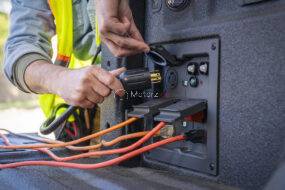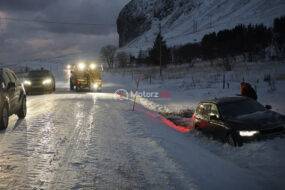Black ice is a thin, transparent layer of ice that forms on roads, making them extremely slippery and dangerous. It’s often difficult to see, even when driving in bright sunlight. Accidents caused by can be serious, so it’s essential to know how to spot it and avoid it.
What is Black Ice?
It is a thin layer of ice that forms on roads when temperatures drop below freezing and the road surface is wet. because it’s nearly invisible to the naked eye. It appears dark and shiny, blending seamlessly with the road surface. This makes it difficult for drivers to see, even in good lighting conditions.
Why is This Dangerous?
It is incredibly dangerous because it provides very little traction. When a car’s tires come into contact, they can lose grip and slide, making it difficult to control the vehicle. This can lead to accidents, such as skidding off the road or colliding with other vehicles.
Factors Contributing to Black Ice Formation
Several factors can contribute to the formation of black ice on roads, including:
Temperature: Temperatures below freezing are essential for formation.
Wet roads: Wet roads provide the moisture necessary for ice to form.
Bridges and overpasses: These structures can freeze before the surrounding road surface due to their exposure to colder air.
Shaded areas: Areas shaded by trees or buildings can remain colder than exposed areas, increasing the risk of black ice formation.
How to Spot Black Ice
While black ice can be difficult to see, there are some signs that you can look for to help you identify it:
Shiny patches: Look for shiny patches on the road that appear dark and reflective.
Foggy patches: If you see foggy patches on the road, it could be a sign.
Reduced traction: If you feel your car’s tires losing traction, it could be a sign that you’re driving.
Tips for Avoiding Black Ice Accidents
If you’re driving in conditions where black ice is possible, here are some tips to help you avoid accidents:
Slow down: Reduce your speed, especially when driving on bridges, overpasses, and shaded areas.
Increase following distance: Maintain a safe following distance between your car and the vehicle in front of you.
Be alert: Pay attention to the road ahead and be prepared to react quickly if you see any signs of black ice.
Avoid sudden braking or acceleration: Sudden changes in speed can cause your car to lose traction and skid.
Use winter tires: Winter tires have a special tread pattern that provides better traction on ice and snow.
Carry an emergency kit: A well-stocked emergency kit can be invaluable if you get stuck in icy conditions.
Understanding Black Ice Formation
Black ice forms when liquid water on a road surface freezes. This typically happens when the road’s temperature drops below freezing, but the air temperature remains above freezing. This temperature differential causes the water to freeze into a thin, transparent layer that’s nearly invisible.
The Dangers of Black Ice
Sudden loss of traction: Black ice offers very little traction between tires and the road. This can cause a car to skid or slide, even at low speeds.
Difficulty in control: Once a car starts to skid on, it can be challenging to regain control. This can lead to accidents, such as collisions, rollovers, and swerving off the road.
Increased risk of injuries: Accidents caused by can result in severe injuries, including broken bones, head trauma, and even fatalities.
Identifying and Avoiding Black Ice
Know the risk factors: Be aware of conditions that favor black ice formation, such as freezing temperatures, wet roads, bridges, overpasses, and shaded areas.
Watch for visual cues: Look for shiny, dark patches on the road, fogging, or reduced traction.
Slow down and increase following distance: Reduce your speed and maintain a safe following distance to give yourself more time to react if you encounter.
Avoid sudden braking or acceleration: These can cause your car to lose traction and skid.
Use winter tires: Winter tires have a special tread pattern that provides better traction on ice and snow.
Be prepared for emergencies: Carry an emergency kit with items like blankets, water, food, a flashlight, and jumper cables.
Driving on Black Ice: What to Do
If you do encounter black ice and your car starts to skid:
Stay calm: Panic can make the situation worse.
Ease off the accelerator: Gradually reduce your speed.
Avoid braking: Braking can lock up your wheels and worsen the skid.
Steer in the direction of the skid: If your car starts to turn, gently turn the steering wheel in the same direction.
Avoid overcorrecting: Overcorrecting can cause your car to spin.
Additional Tips
Check weather forecasts: Be aware of upcoming weather conditions and plan your trips accordingly.
Listen to local news: Stay informed about road conditions and weather alerts.
Consider alternative transportation: If conditions are severe, consider public transportation, carpooling, or staying home.
By understanding the dangers of black ice and following these tips, you can significantly reduce your risk of accidents and stay safe on the roads during winter weather.
Conclusion
Black ice is a serious hazard that can lead to accidents. By understanding what is, how it forms, and how to spot it, you can take steps to avoid it and stay safe on the roads. Remember to slow down, increase following distance, and be alert when driving in icy conditions.





